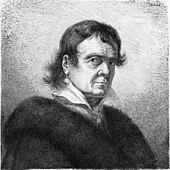Painter Müller

Johannes Friedrich Müller , called painter Müller or Teufelsmüller (born January 13, 1749 in Kreuznach , † April 23, 1825 in Rome ), was a German- Roman painter , engraver and poet of Sturm und Drang .
Life
Müller grew up as the son of the baker, brewer and landlord Johannes Friedrich Müller (1727–1760) in Kreuznach. About his mother Katharina Margaretha Roos (1730–1796) he was a great-grandson of the animal painter Johann Heinrich Roos . After the early death of his father, he broke off his high school and helped in the family business. During this time he made his first drawings and wrote his first poems. He became a pupil of the court painter Johann Christian von Mannlich and Daniel Hiens , the court painter Duke Christian IV. Von Zweibrücken , and studied from 1769 at the art academy in Mannheim , where his interest in the art of antiquity and the Renaissance was aroused. Elector Karl Theodor appointed him his cabinet painter. Since then, Müller has been in contact with Gotthold Ephraim Lessing , Christoph Martin Wieland and Friedrich Schiller . His relationship with Johann Wolfgang von Goethe , of the same age, was initially friendly; Goethe praised Müller's drawings and illustrations and was in lively correspondence with him. In addition, both worked on the Faust fabric; In 1778 a fragment from Müller appeared as "Faust's Life Dramatized" .
In 1778 Müller traveled to Rome , where he stayed until the end of his life and mostly lived in poor conditions. Pictures that Müller sent to Weimar found no favor with Goethe and his friends, which led to Müller's break with Goethe. Since the payments from Mannheim had not been received since 1789, he worked in Rome as a journalist for various German-language magazines and as a tourist guide . In 1805 he was the tour guide of the Bavarian Crown Prince and later King Ludwig I , who awarded him the title of royal Bavarian court painter and gave him a pension. He also met numerous famous travelers of his time, e. B. Ludwig Tieck .
In Rome, Müller continued to work as a poet. In addition to several idylls and the novella “The high saying, or Chares and Fatime” , the dramas “ Golo and Genovefa ” and “Adonis” were created . He also edited his "Faust" into a constitution. In 1811 his "Gesammelte Werke" appeared at Tick's suggestion .
At the age of 76, Müller died in Rome of complications from a stroke .
His nephew Christian Heinrich Gilardone (1798–1874) worked as a local poet in Speyer .
Literary works
Poems
- Full texts available [1]
Novella
- The high saying, or Chares and Fatime
Dramas
- Golo and Genovefa
- Adonis
- fist
literature
- Erich Schmidt : Müller, Friedrich . In: Allgemeine Deutsche Biographie (ADB). Volume 22, Duncker & Humblot, Leipzig 1885, pp. 530-535.
- Karl Goedeke , Edmund Goetze: Outline of the history of German poetry from the sources. 3. Edition. Ehlermann, Leipzig 1916, vol. 4, div. 1, pp 890 -907.
- Ulrike Leuschner: Müller, Friedrich (called painter Müller). In: New German Biography (NDB). Volume 18, Duncker & Humblot, Berlin 1997, ISBN 3-428-00199-0 , pp. 373-375 ( digitized version ).
- Johannes Mumbauer : Painter Müller in Rome, 1913.
- Rolf Paulus, Eckhard Faul: Painter-Müller-Bibliography . Winter, Heidelberg 2000 ISBN 3-8253-1041-8 .
Web links
- Literature by and about Friedrich Müller in the catalog of the German National Library
- The shorn sheep. On Friedrich Müller's Palatine idylls by Günter Häntzschel (PDF file; 67 kB)
- Works by painter Müller at Zeno.org .
Individual evidence
- ^ Heinrich Wilhelm Stieglitz : Memories of Rome and the Papal States in the first year of its rejuvenation . FA Brockhaus, Leipzig 1848, p. 128 ( Google Books )
- ^ Friedrich Noack : The Germanness in Rome since the end of the Middle Ages . Deutsche Verlagsanstalt, Stuttgart 1927, Volume 2, pp. 219, 412 f.
- ↑ Siegmund thoes-Kössel: Views of the painter Friedrich Müller (1749-1825) . (Saarbrücker Contributions to Literary Studies 41). Röhrig, St. Ingbert 1993, p. 47.
| personal data | |
|---|---|
| SURNAME | Müller, painter |
| ALTERNATIVE NAMES | Müller, Friedrich (maiden name); Teufelsmüller (nickname) |
| BRIEF DESCRIPTION | German painter, engraver and poet of Sturm und Drang |
| DATE OF BIRTH | January 13, 1749 |
| PLACE OF BIRTH | Kreuznach |
| DATE OF DEATH | April 23, 1825 |
| Place of death | Rome |

